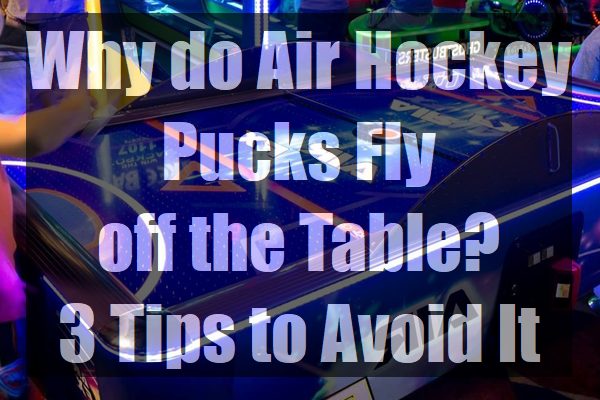
Why do Air Hockey Pucks Fly off the Table? 3 Tips to Avoid It
Flying pucks are always a hazard. Even in ice hockey games it's difficult to keep the puck on the ice and from flying into the crowd. You can expect pucks to fly off the air hockey table as it's a part of the game.
Why do air hockey pucks fly off the table? The best answer is that the air flow from the blower is just too strong for the puck. The air flow lifts the puck and the velocity keeps it moving away from the playing surface.
There are several ways to stop the puck from leaving your air hockey playing surface. Just continue to read our article to find out how to do it.
Air Hockey Puck Keeps Flying off the Table

If you are having trouble keeping your air hockey puck on the playing surface, there are steps you can take to prevent it from happening. But first lets look at a couple of reasons why this takes place.
#1. The air blower puts out too much air- unfortunately, most manufacturers make the air blowers operate at one speed. This means you cannot adjust the air flow and the pucks will continue to fly away.
#2. The puck is damaged- if you have dents or chips in the puck, then it doesn’t sit evenly on the playing surface. This raised edge helps catch the flowing air and lifts up the puck and it starts to fly.
#3. The weight of the puck- if the puck is too light, then the air flow will lift the puck up and the velocity will send it off the table.
3 Tips to Stop Air Hockey Flying Pucks
The tips are not complicated and they are not hard to implement. The principle keep it simple, applies to most solutions to a majority of problems.
- Use sand paper- sanding down the puck will make it smooth again and lie flay on your table. You need to remove dents and nicks if you want your puck to stay on your air hockey table
- Replace your puck- these pucks are not expensive, so replacing them with a heavier one will not break your budget. Knockoff manufacturers and companies wanting to save a few bucks put pucks in their games that are too light. It saves them money but makes playing the game harder for you
- Change paddles- the heavier the paddle the more force you are applying to the puck. The more force that is applied, the faster the puck goes. Air hockey tables are not always built to handle high speeds, so the puck leaves the table.
Honorable mentions:
First, if you can’t stop the game and rush out and buy a new heavier puck, you can try to tape a quarter or fifty cent piece to the puck to weigh it down. Or you may have to use a dime, nickel or penny to adjust the weight
Second, make sure the table and air holes are clean and there are no raised areas on the laminated surface.
Third, you can spend a lot of money and buy a different air blower that doesn’t blow the air as hard. This is a last resort of course.
Air Hockey Puck Weight

Finding the right weight of puck for your air hockey game is not that difficult. The easiest weigh to do it is to go by the size of your table.
7 to 8 foot table- should have a puck size of 3 1/2 inches and weigh roughly 42 grams or a bit less.
5 to 6 foot tables- should use a 2 1/2 inch puck that weighs in the neighborhood of 30 grams
4 foot and smaller tables- can use 1 4/5 inch pucks and their weight should not exceed 9 grams
Air Hockey Pucks Too Light
This is a common hazard as some manufactures produce an inferior air hockey product including pucks. They are not interested in producing the right weight and size of puck for the tables they make. The bottom line matters more to them.
When you come across this situation, you should replace the pucks for a heavier model. Don’t assume that the manufacturer is putting the right pucks in the box with the air hockey table. Weigh them and see if they match the scale listed above.
Pucks are cheap, so getting a large amount of replacements is the best way to go.
Chuck the Puck Air Hockey
There are different versions of air hockey games you can play. One of those versions is to use a soft puck and toss it at a target. You can play on a variety of surfaces and present good rewards for those participants with the best accuracy.
Another version of air hockey comes out of the state of Michigan. One company has created a life size version of the game. It can be played on a 24 by 40 foot rink,, uses a flatter puck than a ice hockey one and it still uses air holes and blowers top move the puck around.
Instead of paddles, you get to use sticks and it is possible to use inline roller blades to move you around the rink. At least that is the goal of the company Goals are worth 1 point and there is a slot in the back of the net that is worth 2 points if you get the puck inside.
Answering your questions:
#1. Is there a way to cut the noise down when playing air hockey?
Yes there is. One company does make rubber coated pucks that move just like a regular one except they do not make any noise
#2. What size pucks do the professionals use?
Their pucks are 3 1/2 inches in diameter but they also play with 3 1/4 inch diameter pucks.
Some Final Comments
As you can see, keeping your air hockey puck on your air hockey table surface is not a difficult problem to solve. It may take a little experimenting to get the right weight and alternative solutions to work for you but at least the pucks will stay where it is supposed to be.
Go for the easiest solutions first, then work your way up to the more expensive ones. The last tip you can consider is how hard you hit the puck. You may keep the puck on the surface longer if you ease up on your hitting stroke and not use so much power.

